Table of Contents
Have you ever wondered why chevaline has become a delicacy in some parts of the world?
It may come as a surprise to many, but horse meat is actually quite a popular dish in certain countries.
In this blog post, we will be exploring the history of horse meat consumption, the reasons why it is sought after, and the health benefits it can offer.
Also, we will be exploring the precautions someone needs to take before consuming chevaline alongside tips on how to buy + cook + store it.
So, if you’re curious to learn more about the surprising culinary history of horse meat, then keep reading!
Chevaline: history
Archaeologists found the oldest piece of horse meat for human consumption preserved in a bronze cauldron and dating back 5 thousand years.
With such proof, horse meat AKA “chevaline” were among the first types of meat to be consumed by men.
It is believed that the first domestication of horses began about 5000 years ago when they were used as meat suppliers.
However, a few centuries later men started using the power of horses to ride them when traveling or to use them in hard labor.
In fact, the transport and agriculture revolutions are directly linked to the horse and could’ve not been done without it.
Since horses became very valuable in the daily lives of men, they earned a good reputation as the comrade of knights.
Stories have been written across cultures about the loyalty of horses that fought alongside men in wars.
Because of that, many people nowadays can’t even imagine consuming the meat of a horse as the animal represent a loyal human friend to them.
However, in many places around the world people highly value horse meat and still use it in traditional preparations.
In fact, many Germanic and Turc tribes consume chevaline and consider it to be the noblest type of meat.
Nowadays, specific breeds of horses are being bred mainly for the production of meat in countries like Germany, China, Kazakhstan, Mexico…
Breeding horses is more saint for the environment as they produce fewer CO2 emissions compared to cattle.
This explains that there is still a high demand for this type of meat and the market is still beneficial.
Difference between beef and chevaline:
In terms of color, horse meat tends to have a darker red color than beef which tends to be lighter.
That is due to the higher presence of iron in chevaline which is needed to further oxygenate the muscles.
As for tenderness, beef is tougher with white fats while chevaline has yellow fat and tends to be very tender.
Horses are runners so they have thicker muscle fibers which can be seen in their meat compared to beef muscle tissues which are thinner.
Finally, beef can sometimes have a strong smell, while horse meat doesn’t have a particular smell.
Chevaline nutritional values and health benefits:
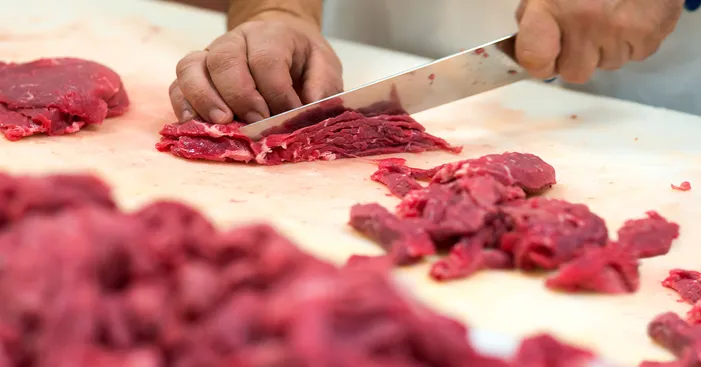
Nutritional values:
Based on the nutritional values provided by the USDA, 3 ounces of chevaline (85g) only contain 149 calories.
However, 70% of these calories come from protein which makes this one of the leanest red meat.
For that same serving, your body will receive only 5.1g of fat (8% Daily Value) and less than 58mg of cholesterol (19% DV).
This is due to many factors including the diet of a horse which is mostly grass without grains or sources of fats.
In addition, these animals run a lot and burn a lot of calories which makes their meat less fatty.
Chevaline offers around 24g of protein per serving of 85g (3 ounces) which is almost the same as beef.
As for the vitamins, this meat offers a lot of vitamins including B vitamins, choline, Vitamin E and C.
Not only vitamins, chevaline also offers many minerals such as Iron, Copper, Phosphorus, Selenium, and Zinc.
These data count for the recommended daily intake of (85g to 3oz) cooked chevaline:
- Calories: 149
- Protein: 24g
- Cholesterol: 58mg
- Fat: 5.1g
- C vitamin: 2%
- B1 vitamin: 7%
- B3 vitamin: 26%
- B6 vitamin: 17%
- B12 vitamin: 112%
- Copper: 17%
- Iron: 24%
- Magnesium: 5%
- Phosphorus: 17%
- Potassium: 7%
- Zinc: 30%
- Selenium: 21%
Health benefits:
Even though chevaline is not a very famous red meat, especially in the Western world, it has many good properties.
For instance, the meat of a horse is leaner than pork or beef and can be as light as poultry because it contains so much fewer fats.
Many experts have done studies and spoken about the many health benefits of horse meat for human consumption.
Here are some of the many health benefits of chevaline:
Provides good quality protein:
This meat offers a good amount of protein with almost 40% of the daily needs in 3 ounces (85g).
However, the amount of all the nutrients in horse meat depends on the diet of the animal and its age.
Not only that but also within the same animal the nutrients including protein may change depending on the area of the cut.
A good source of vitamins:
As one of the richest red meats when it comes to vitamins, chevaline offers:
- Vitamin B1: Promotes stress resistance and is involved in the metabolism.
- Vitamin B2: Protects against inflammation and fights free radicals.
- Vitamin B3: Reduces blood pressure and promotes a healthier brain.
- Vitamin B6: Promotes healthy growth and healthy brain development.
- Vitamin 12: Needed to create DNA, red blood cells, and nerves.
Helps fight anemia:
As one of the richest meats in Iron, horse meat offers more than 20% of the daily needs of Iron per serving (3oz).
Not only that, the majority of that Iron is particularly “heme Iron” which is the easiest form to absorb by the body.
This abundance of Iron is superior to chicken, beef, and lamb and falls slightly behind duck, quail, and venison.
Because of that, this meat is recommended for those dealing with Iron deficiency and anemia.
The combination of vitamin B12 and Iron gives the body the essential elements to produce healthy blood.
Low in calories and fats:
Among the many advantages of chevaline is the fact that it contains very low-fat content and it has one of the lowest caloric values.
In fact, as red meat, the caloric value of horse meat is very similar to that of poultry.
This is very beneficial for people dealing with high cholesterol levels, bad cardiovascular health, or obesity.
A great source of minerals:
Chevaline is a great source of many minerals but here are the most abundant ones:
- Copper: Involved in the production of blood.
- Iron: Essential in the creation of hemoglobin which transports oxygen throughout the body.
- Phosphorus: the second most abundant mineral in the body and very essential in the formation of bones and teeth.
- Selenium: Protects against infections and inflammation.
- Zinc: The body uses this mineral to regenerate damaged tissue and fight free radicals.
- Potassium: Provides normal blood fluidity to help counter the effects of hypertension and hypotension.
- Magnesium: Maintains normal blood pressure which promotes a regular heart beating.
Precautions before you consume chevaline:
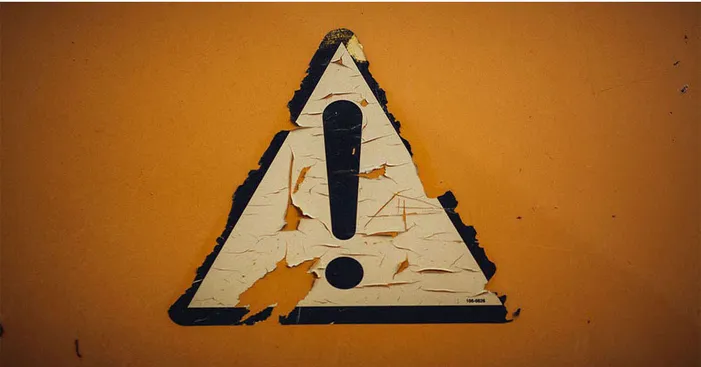
Regardless of the food you eat, you should consume it properly and not go overboard and this also applies to chevaline.
The most prominent disadvantage of horse meat is its low carbohydrate content which directly impacts its shelf life.
Once it spoils, horse meat can provide a good environment for bad bacteria like salmonella, E.coli, and Trichinella.
Therefore, we should know how to properly store this type of meat as we are going to mention later.
Some ingredients shouldn’t be mixed with horses including mushrooms, ginger…
This is because consuming this type of meat with mushrooms could cause fever, vomiting, nausea, and other discomforts.
Also, the combination of horse meat with ginger could have a contraction as they both promote blood thinning.
In addition, avoid consuming chevaline because it may contain bacteria that can cause major intestinal illnesses.
Nonetheless, horse meat is considered one of the most saint and environmentally friendly meat because it contains no harmful substances.
As for handling, chevaline may be very tough, especially with large cuts like steaks which is why it requires 2 to 3 hours of cooking.
Finally, some people don’t like the strong taste of horse meat which may be repelling for some people and some even said it tastes like grass.
To reduce that issue, it is recommended to marinate it for 2 hours in water with garlic, parsley, thyme, cloves…
Using horse meat:
Thanks to its tenderness, horse meat is very easy to cook and generally requires less time than beef to be cooked.
To further enhance the flavor of horse meat, we should use spices and herbs like garlic, basil, rosemary, oregano, thyme, and tarragon.
Just like any other meat, horse meat steaks need to be cooked in a very hot pan with butter or vegetable oil.
This meat can be used in the same way as beef, lamb, or venison in soups, stews, roasted, barbecued, in the oven…
Here are a few traditional chevaline dishes from around the world:
German horse soup:
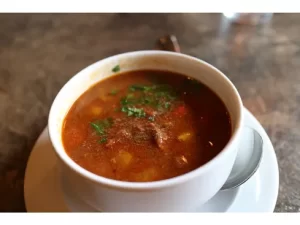
Ingredients:
- 2 lbs of horse meat (ribs or shoulder cuts)
- 3 chopped onions.
- 4 cups of broth.
- 2 bay leaves.
- 3 cloves.
- 1 lemon.
- 3 ounces of butter (80g).
- 1 lb of potatoes.
- 1 tsp of salt and pepper.
Preparation:
- Start by washing the meat in tap water then dry it with a piece of cloth.
- Cut the chevaline into small bite-size pieces, put them in a bowl, and season them with salt and pepper.
- Cover the bowl and let it rest in a cool place while you work on the other ingredients.
- Heat a pan then melt the butter before you start frying the finely chopped onion.
- Add the pieces of meat and fry them until they turn golden brown then add the broth.
- Don’t forget to check the firmness of the meat from time to time.
- Meanwhile, peel the potatoes and cut them into small cubic pieces.
- Add the potato pieces to the soup alongside bay leaves, and cloves.
- Juice the lemon on the soup and let it cook until the potato pieces become soft.
- Serve it with bread and enjoy it with your loved ones!
Sauteed chevaline:
Ingredients:
- 1 lb of horse meat (chevaline).
- 5 carrots.
- 1 bell pepper.
- 2 cloves of garlic.
- 1 zucchini.
- 2 cups of snow peas (200g).
- 1 onion.
- 2 tbsp of sesame oil.
- 1 lemon.
- 2 tbsps of soy sauce.
- 1 tsp of salt and pepper.
- 1 tbsp of sunflower oil.
Preparation:
- Start by washing the meat, then dry it and cut the meat into small pieces.
- Heat sunflower oil in a frying pan then simmers the pieces of meat for 2 minutes.
- Add 1 tbsp of soy sauce and keep stirring while the meat cooks.
- Take off the meat pieces and put them on a dish and cover it with aluminum foil to maintain its warmth.
- Cut the vegetables into small pieces including carrots, zucchini, bell pepper, snow peas, and garlic.
- Now sautee the chopped vegetables in the meat juices that remained in the pan.
- When the vegetables become soft, juice lemon juice in the pan and add 1 tbsp of soy sauce.
- Now add the premade pieces of meat alongside sesame oil and stir while the mixture of meat and vegetables is cooking for 1 minute.
- Season with salt and pepper and serve on its own or accompanied by boiled rice!
Storing horse meat:
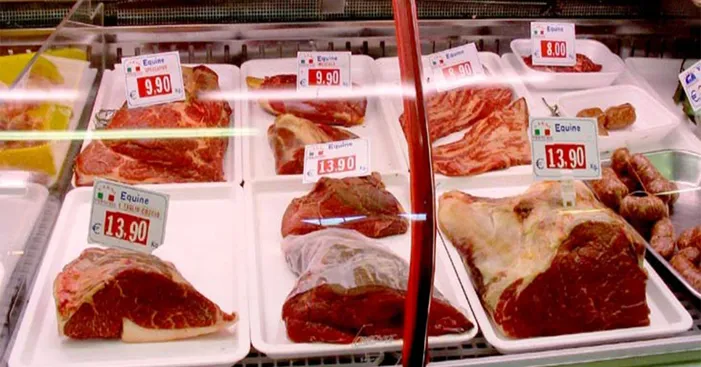
Horse meat is very rare and spoils fast because it oxidizes quickly once we expose it to air.
This is due to the high presence of Iron which makes the meat look dark red but also makes it spoil quickly.
Nonetheless, there are a few tricks you can do to extend the shelf life of chevaline:
- If you buy ground horse meat make sure you consume it within one day.
- You can store raw horse meat for 3 days in the fridge while keeping it in its original packaging.
- For a longer shelf life, you can freeze this meat in an airtight container for up to 4 months.
- Make sure you defrost it in the fridge to avoid temperature changes which can promote spoilage.
- As for cooked chevaline, you can keep it in the fridge but you must consume it within 2 days.
Buying horse meat:
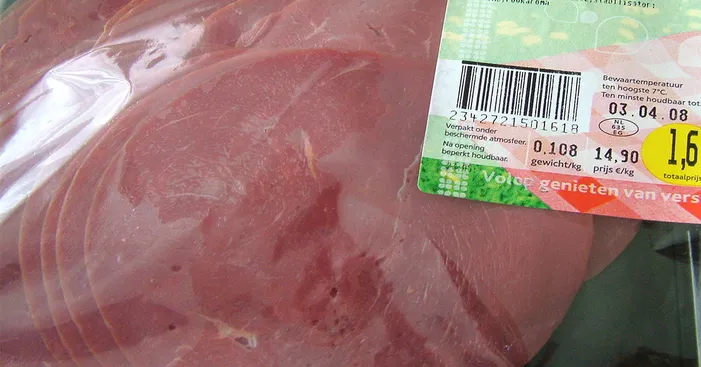
Just like beef, horse meat is very tender in general even though there are different cuts with different characteristics.
Here are a few tips to help you choose the most suitable cut for your preparation:
Tenderloin is the most tender cut of chevaline and you can find it as a steak, barded roasts, or tournedos.
Good quality horse meat is dark red and should be moist and not sticky.
For barbecuing go for short ribs with their delicious marbled composition.
The leanest cuts of chevaline are the rib eye, the rump steak, and the tenderloin.
To make ground horse meat you would need to choose the chuck, the breast,
For roasting, you would need to choose one of the noble cuts which are the round or the rump steak.

